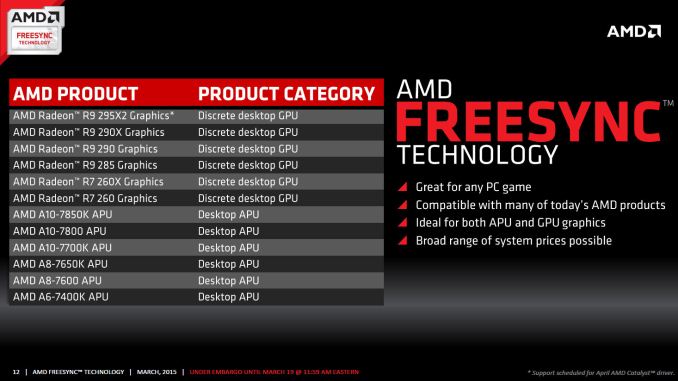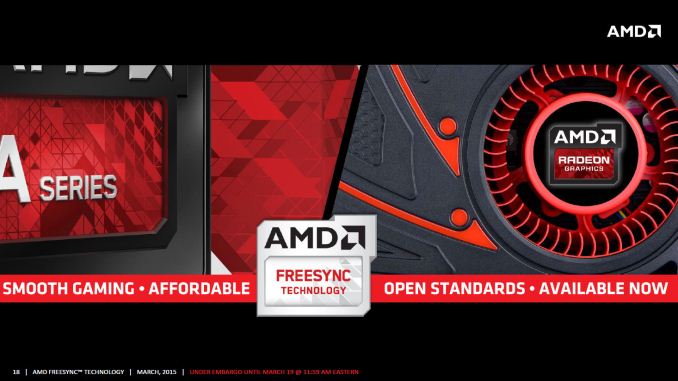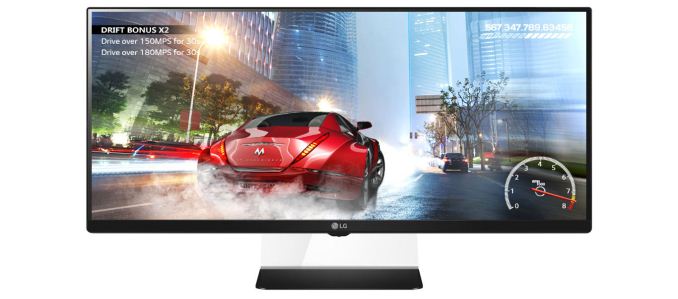The AMD FreeSync Review
by Jarred Walton on March 19, 2015 12:00 PM ESTClosing Thoughts
It took a while to get here, but if the proof is in the eating of the pudding, FreeSync tastes just as good as G-SYNC when it comes to adaptive refresh rates. Within the supported refresh rate range, I found nothing to complain about. Perhaps more importantly, while you’re not getting a “free” monitor upgrade, the current prices of the FreeSync displays are very close to what you’d pay for an equivalent display that doesn’t have adaptive sync. That’s great news, and with the major scaler manufacturers on board with adaptive sync the price disparity should only shrink over time.
The short summary is that FreeSync works just as you’d expect, and at least in our limited testing so far there have been no problems. Which isn’t to say that FreeSync will work with every possible AMD setup right now. As noted last month, the initial FreeSync driver that AMD provided (Catalyst 15.3 Beta 1) only allows FreeSync to work with single GPU configurations. Another driver should be coming next month that will support FreeSync with CrossFire setups.
Besides needing a driver and FreeSync display, you also need a GPU that uses AMD’s GCN 1.1 or later architecture. The list at present consists of the R7 260/260X, R9 285, R9 290/290X/295X2 discrete GPUs, as well as the Kaveri APUs – A6-7400K, A8-7600/7650K, and A10-7700K/7800/7850K. First generation GCN 1.0 cards (HD 7950/7970 or R9 280/280X and similar) are not supported.
All is not sunshine and roses, however. Part of the problem with reviewing something like FreeSync is that we're inherently tied to the hardware we receive, in this case the LG 34UM67 display. Armed with an R9 290X and running at the native resolution, the vast majority of games will run at 48FPS or above even at maximum detail settings, though of course there are exceptions. This means they look and feel smooth. But what happens with more demanding games or with lower performance GPUs? If you're running without VSYNC, you'd get tearing below 48FPS, while with VSYNC you'd get stuttering.
Neither is ideal, but how much this impacts your experience will depend on the game and individual. G-SYNC handles dropping below the minimum FPS more gracefully than FreeSync, though if you're routinely falling below the minimum FreeSync refresh rate we'd argue that you should lower the settings. Mostly what you get with FreeSync/G-SYNC is the ability to have smooth gaming at 40-60 FPS and not just 60+ FPS.
Other sites are reporting ghosting on FreeSync displays, but that's not inherent to the technology. Rather, it's a display specific problem (just as the amount of ghosting on normal LCDs is display specific). Using higher quality panels and hardware designed to reduce/eliminate ghosting is the solution. The FreeSync displays so far appear to not have the same level of anti-ghosting as the currently available G-SYNC panels, which is unfortunate if true. (Note that we've only looked at the LG 34UM67, so we can't report on all the FreeSync displays.) Again, ghosting shouldn't be a FreeSync issue so much as a panel/scaler/firmware problem, so we'll hold off on further commentary until we get to the monitor reviews.
One final topic to address is something that has become more noticeable to me over the past few months. While G-SYNC/FreeSync can make a big difference when frame rates are in the 40~75 FPS range, as you go beyond that point the benefits are a lot less clear. Take the 144Hz ASUS ROG Swift as an example. Even with G-SYNC disabled, the 144Hz refresh rate makes tearing rather difficult to spot, at least in my experience. Considering pixel response times for LCDs are not instantaneous and combine that with the way our human eyes and brain process the world and for all the hype I still think having high refresh rates with VSYNC disabled gets you 98% of the way to the goal of smooth gaming with no noticeable visual artifacts (at least for those of us without superhuman eyesight).
Overall, I’m impressed with what AMD has delivered so far with FreeSync. AMD gamers in particular will want to keep an eye on the new and upcoming FreeSync displays. They may not be the “must have” upgrade right now, but if you’re in the market and the price premium is less than $50, why not get FreeSync? On the other hand, for NVIDIA users things just got more complicated. Assuming you haven’t already jumped on the G-SYNC train, there’s now this question of whether or not NVIDIA will support non-G-SYNC displays that implement DisplayPort’s Adaptive Sync technology. I have little doubt that NVIDIA can support FreeSync panels, but whether they will support them is far less certain. Given the current price premium on G-SYNC displays, it’s probably a good time to sit back and wait a few months to see how things develop.
There is one G-SYNC display that I’m still waiting to see, however: Acer’s 27” 1440p144 IPS (AHVA) XB270HU. It was teased at CES and it could very well be the holy grail of displays. It’s scheduled to launch next month, and official pricing is $799 (with some pre-orders now online at higher prices). We might see a FreeSync variant of the XB270HU as well in the coming months, if not from Acer than likely from some other manufacturer. For those that work with images and movies as well as playing games, IPS/AHVA displays with G-SYNC or FreeSync support are definitely needed.
Wrapping up, if you haven’t upgraded your display in a while, now is a good time to take stock of the various options. IPS and other wide viewing angle displays have come down quite a bit in pricing, and there are overclockable 27” and 30” IPS displays that don’t cost much at all. Unfortunately, if you want a guaranteed high refresh rate, there’s a good chance you’re going to have to settle for TN. The new UltraWide LG displays with 75Hz IPS panels at least deliver a moderate improvement though, and they now come with FreeSync as an added bonus.
Considering a good display can last 5+ years, making a larger investment isn’t a bad idea, but by the same token rushing into a new display isn’t advisable either as you don't want to end up stuck with a "lemon" or a dead technology. Take some time, read the reviews, and then find the display that you will be happy to use for the next half decade. At least by then we should have a better idea of which display technologies will stick around.













350 Comments
View All Comments
JarredWalton - Friday, March 20, 2015 - link
FYI, ghosting is a factor of the display and firmware, not of the inherent technology. So while it's valid to say, "The LG FreeSync display has ghosting..." you shouldn't by extension imply FreeSync in and of itself is the cause of ghosting.chizow - Friday, March 20, 2015 - link
So are you saying a firmware flash is goiing to fix this, essentially for free? Yes that is a bit of a troll but you get the picture. Stop making excuses for AMD and ask these questions to them and panel makers, on record, for real answers. All this conjecture and excuse-making is honestly a disservice to your readers who are going to make some massive investment (not really) into a panel that I would consider completely unusable.You remember that Gateway FPD2485W that you did a fantastic review of a few years ago? Would you go back to that as your primary gaming monitor today? Then why dismiss this problem with FreeSync circa 2015?
chizow - Friday, March 20, 2015 - link
Who said no ghosting? lol. There's lots of ghosting, on the FreeSync panels.TheJian - Sunday, March 22, 2015 - link
You're assuming gsync stays the same price forever. So scalers can improve pricing (in your mind) to zero over time, but NV's will never shrink, get better revs etc...LOL. OK. Also you assume they can't just lower the price any day of the week if desired. Microsoft just decided to give away Windows 10 (only to slow android but still). This is the kind of thing a company can do when they have 3.7B in the bank and no debt (NV, they have debt but if paid off, they'd have ~3.7b left). They could certainly put out a better rev that is cheaper, or subsidize $50-100 of it for a while until they can put out a cheaper version just to slow AMD down.They are not equal. See other site reviews besides and AMD portal site like anandtech ;)
http://www.pcper.com/reviews/Displays/AMD-FreeSync...
There is no lic fee from NV according to PCper.
"It might be a matter of semantics to some, but a licensing fee is not being charged, as instead the vendor is paying a fee in the range of $40-60 for the module that handles the G-Sync logic."
Which basically shows VENDORS must be marking things up quite a lot. But that is too be expected with ZERO competition until this week.
"For NVIDIA users though, G-Sync is supported on GTX 900-series, 700-series and 600-series cards nearly across the board, in part thanks to the implementation of the G-Sync module itself."
Not the case on the AMD side as he says. So again not so free if you don't own a card. NV people that own a card already are basically covered, just buy a monitor.
Specs of this is misleading too, which anandtech just blows by:
"The published refresh rate is more than a bit misleading. AMD claims that FreeSync is rated at 9-240 Hz while G-Sync is only quoted at 30-144 Hz. There are two issues with this. First, FreeSync doesn’t determine the range of variable refresh rates, AdaptiveSync does. Second, AMD is using the maximum and minimum refresh range published by the standards body, not an actual implementation or even a planned implementation from any monitor or display. The 30-144 Hz rating for G-Sync is actually seen in shipping displays today (like the ASUS PG278Q ROG Swift). The FreeSync monitors we have in our office are either 40-144 Hz (TN, 2560x1440) or 48-75 Hz (IPS, 2560x1080); neither of which is close to the 9-240 Hz seen in this table."
Again, read a site that doesn't lean so heavily to AMD. Don't forget to read about the GHOSTING on AMD. One more point, PCper's conclusion:
"My time with today’s version of FreeSync definitely show it as a step in the right direction but I think it is far from perfect."
"But there is room for improvement: ghosting concerns, improving the transition experience between VRR windows and non-VRR frame rates and figuring out a way to enable tear-free and stutter-free gaming under the minimum variable refresh rate."
"FreeSync is doing the right things and is headed in the right direction, but it can’t claim to offer the same experience as G-Sync. Yet."
Ok then...Maybe Freesync rev2 gets it right ;)
soccerballtux - Friday, March 20, 2015 - link
you must be a headcase or, more likely, are paid for by NVidia to publicly shill. Gsync requires a proprietary NVidia chip installed in the monitor that comes from, and only from, NVidia.It's much easier to simply set a flag-byte in the DisplayPort data stream that says "ok render everything since the last render you rendered, now". There's nothing closed about that.
chizow - Friday, March 20, 2015 - link
And? Who cares if it results in a better solution? LOL only a headcase or a paid AMD shill would say removing hardware for a cheaper solution that results in a worst solution is actually better.soccerballtux - Friday, March 20, 2015 - link
wellll, if it's cheaper and a better solution, then the market cares.chizow - Friday, March 20, 2015 - link
Except its cheaper and worst, therefore it should be cheaperbloodypulp - Friday, March 20, 2015 - link
Oh darn... so what you're saying is that I have to purchase the card that costs less, then I have to purchase the monitor that costs less too? Sound like a raw deal... ROFL!!And as far as your bogus oppenness argument goes: There is nothing preventing Nvidia from supporting Adaptive Sync. NOTHING. Well, unless you count hubris and greed. In fact, Mobile G-Sync already doesn't even require the module! I guess that expensive module really wasn't necessary after all...
And lastly, Nvidia has no x86 APU to offer, so they can't offer what AMD can with their Freesync-supporting APUs. Nvidia simply has nothing to compete with there. Even gamers on a tight budget can enjoy Freesync! The same simply cannot be said for GSync.
Denithor - Friday, March 20, 2015 - link
ONLY closed because NVIDIA refuses to support freesync. Much like OpenCL. And PhysX.